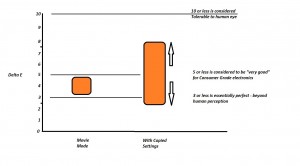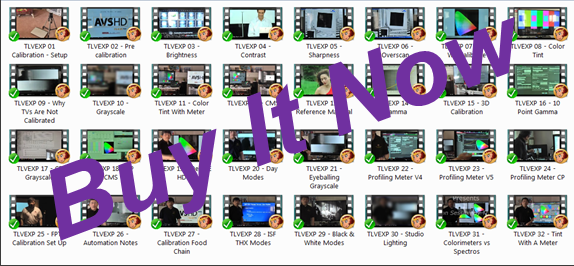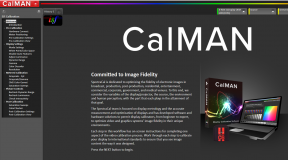 The fruits of copying settings. The Pioneer Lottery. So what really happens when people start to copy numbers from other people’s TV sets? Why everyone gets calibrated TVs for free of course. This is so easy, why didn’t anyone ever think of this before? Copying TV settings is so easy.
The fruits of copying settings. The Pioneer Lottery. So what really happens when people start to copy numbers from other people’s TV sets? Why everyone gets calibrated TVs for free of course. This is so easy, why didn’t anyone ever think of this before? Copying TV settings is so easy.
Of course things like different cable boxes and BD players and surround receivers and front projection screen material and the color of the walls and ceiling have no impact on the end result. And before we even get to the stuff you connect to your TV, let’s look at that TV by itself. A TV is made up of components … resisters and capacitors and a whole bunch of other good things. If we tore any TV apart, we may find 1,000 different components or more in that TV. So who wants to guess what the variations are for each part? Do those resistors have a parts tolerance of 0%? Is every resistor exactly the same as the next one when you manufacture them?
If you think yes, then unfortunately, you need your head examined. Even NASA grade components have some level of variance from one part to another. This is an imperfect world after all and no two parts will ever be totally alike. How much would our TVs cost if they were made with components with that tight tolerance that NASA requires … or the military? A $1000 TV balloons to $10000. Linn Audio out of England sold a CD player with hand picked components and a tolerance of 3% for all the parts. This player cost $11,000. Compare this to a $28 DVD player from Walmart that also plays CDs. What do you think the parts tolerance is in that DVD player? What is the parts tolerance in consumer electronics that we buy today? Think it is that 3% that LINN uses? Try 5% to 10% tolerance for each part going into the TV.
If you play the lottery and ever wonder about the odds of winning a 6/49 as available in Canada, it works kind of like this. Chance of getting one number right … 1 in 49. Chance of getting a second number correct … 1 in 48. Chance of getting a third number correct … 1 in 47. Probability of getting 3 numbers right is 49x48x47= 110,544. 1 in 110,544. Now let’s play with the parts tolerance on the TVs. The same set of numbers applied to the first TV on an assembly line will likely not work for the second TV coming off the same line. Maybe it is close, maybe way off. Now factor in one person using a $28 DVD player and another using a $500 one. Think those two players perform the same way?
They should all perform the same way because this is the digital age. It’s all the same 1’s and 0’s. Well, the last time I opened the back of a TV set, I did not see a bunch of 1’s and 0’s floating around. I looked really hard too. Digital medium built in an analog world with analog parts by imperfect humans. But don’t let something as silly as facts and logic get in the way of you copying settings.
Below is a graphic that illustrates a survey that was conducted in 2008 to 2010 on Pioneer Elite plasma TVs in many people’s homes. Of course Pioneer stopped making these sets by 2010 due in part to losing lots of money since they were just not able to make any money on these displays. There was also some partnership deal they had with Panasonic that also played into how things turned out.
In all, 50 TVs were charted in the survey based on their factory preset “Pure” mode and then the same copied calibration settings were put into the TV Pure mode. In all cases, the owners had already put in the copied settings that they had found off the internet. We did not have to put these numbers in at all.
So what were the findings? Well, using the dE scale as a way of judging how things turned out, we learned the following:
First up, a quick summary on how to interpret dE numbers.
10 or less = an error that is tolerable to the human eye. (As in … I can see that it is green tinted, but it is not so green that it makes me not want to watch the TV. So I tolerate the error.)
5 or less = very good performance for a consumer grade product. This is pretty much every TV on the market outside of professional grade stuff meant for TV studios.
3 or less = effectively perfect as errors here are beyond human perception. Precision instruments can see the difference between a dE 0.5 and dE 2.5. Human eyes cannot, hence beyond human perception.
The stock pure mode in the Pioneer sets had a performance range of consistently between dE 3.5 to dE 4.5. If you did nothing and just selected the Pure mode on the TV, you were pretty much guaranteed performance that was better than just “very good” and short of “perfect.” This extremely tight performance range is a testament to just how well built these TVs were. There was a reason they cost what they cost. No TVs on the market since these Pioneer sets vanished have had this level of out of the box consistency. (THX certified sets seem to have a range between dE 4.0 and dE 7.0.)
So with such a tight tolerance, what happened when people started to use the copied settings in their displays? Those copied settings would be better than what the TV came with, right? Of course right.
Not surprisingly, the performance range of the Pure mode widened considerably as a result. The dE range widened up to dE 2.5 to dE 8.0. Instead of a 1 dE variance between displays, this increased to 5.5 dE. On the positive side, the performance range improved to dE 2.5 on the low end which meant that some displays actually benefited from the copied settings. Of course on the negative side, some displays went from very good performance and got much worse, approaching the good to mediocre performance range.
So with 50 TVs, who won the Pioneer Lottery and who lost? Anyone that got a better dE than 3.5 was considered to be a winner. Drum roll please.
2 out of 50 TVs ended up better as a result of copying the settings. That’s 4%. The flip side is that a whopping 96% of the people ended up no better than where they started or made things even worse.
And like lottery tickets, everyone is convinced that they have the winning ticket and nothing you say will convince them otherwise. The only way to really know is to verify your ticket with the winning numbers (or verify it with real instrumentation). So 100% of the people are winners and since they have no interest in any verification, they can continue to “feel like” winners. It’s like the “thanks for participating” prize that gets handed out to all the students for coming out to track and field day.
Pioneer sets had this amazing level of consistency. On a basic level, one would find the following variances with each of these controls. In most cases, one of these these settings below turned out to be the best calibrated setting for that TV. (The Orange color denotes what the default value was)
- Contrast (38, 39, 40)
- Brightness (-1, 0, +1)
- Color (0, 1, 2, 3, 4, 5, 6)
- Tint (G1, 0, R1)
- Sharpness (-9, -10, -11)
So if you copied over 38 for contrast on your TV and 40 was actually the best setting, then you have made things worse. If you took -1 for brightness and +1 was the best, you have made this worse still. And so forth. What is really funny is that to set these particular controls correctly, it really takes no more than 5 minutes when going through even a free test disc.
I shudder to think what applying random numbers to the current sets out there will really do to them. If the same starting numbers of a Panasonic already result in a variance of dE 3, where does that leave the end result when people start to apply other peoples settings to the mix? But everyone is a winner. Keep saying that to yourself. Self deception is a good thing.
Addendum May 15, 2013
But here’s a bit on the positive side of things … so you don’t get the idea that I think copying is evil.
The biggest gain in the copying of settings is actually a result of something that has little to do with most of those settings. Think of it like a smoker that is told to both quit his habit and eat a salad everyday. In time, he feels much better, but he attributes the success mostly to the salad that he eats when in fact, the biggest improvement actually came from just the act of quitting smoking.
The largest picture improvement leap in the process of copying of settings is actually going from the vivid/dynamic mode on the TV over to the Cinema/THX mode. Scientifically this single change can improve image quality by a factor of 5 over anything else that comes after it. If you understand the concept of dE … you are making a leap from dE numbers often much greater than 20 (really bad) down to something in the 4 to 7 range (good to very good). For the sake of simplicity, we’ll say it gives us a dE 5.5 right in the middle of this range. The rest of the copied numbers could move this dE 5.5 number in either direction. It could get as good as 2.5 or a bit worse into the 8/9 range. There has really been no instance of copied numbers taking things back out to 20 again.
(Here’s an even simpler take on the preceding paragraph. Vivid mode is universally accepted as being the worst looking mode on any and all TV sets. Let’s give it a ZERO “0” since you can’t get any worse than that. Let’s give a professionally calibrated TV the score of “100” since that is the best the TV will ever be, limitations and all. When you switch from Vivid mode to Movie mode, you jump your score from 0 up to 80, just like that. This is just with the default settings in the Movie mode. Now you start to feed in the rest of all those copied settings, this 80 number will potentially improve, but not much more past 85. The 80 number could also get worse … down to 70. You will never be taken back down to 0.)
So if copying numbers at least takes you from a Dynamic mode of the TV over to the Movie/Cinema/THX modes, then that is a good thing. But it won’t give you much beyond that because you are now hovering in a range where changes by a couple of dE numbers one way or the other are just near impossible to see anyway. It has already been shown that without knowledge and instrumentation, people don’t know what an accurate image looks like anyway. All things being equal, this is why TVs come out of the box looking way bluer because the TV makers already figured out a long time ago that people pick blue images over accurate ones because they simply do not know any better.
Now having just picked Movie mode does not flip some “quality switch” in people’s heads making them suddenly aware of what accurate images look like. They still don’t know what is actually correct and what is not, it simply comes down to viewer preference at this point, trading off one wrong answer for another and picking the image that makes them feel warm and fuzzy.





